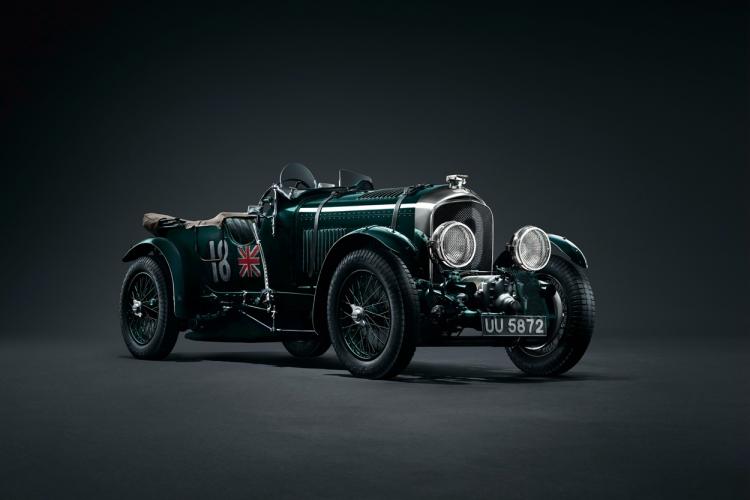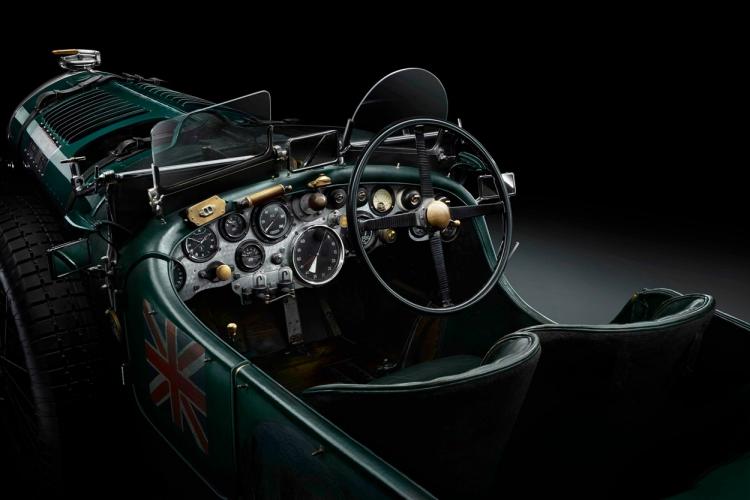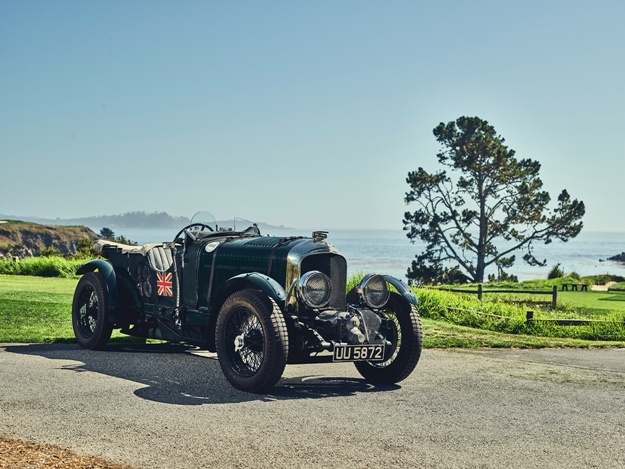In 1929, Sir Tim Birkin presided over the construction of the supercharged 4½-litre Bentley Blower racing car. The Bentley brand drew inspiration from this legendary car and crafted 12 Bentley Blower continuation models. Each new car has been handcrafted by a team of specialists at Mulliner, Bentley’s bespoke bespoke division, as a tribute to Bentley’s pre-war motor racing success.
Sir Tim Birkin led the building of four Bentley Blower racing cars in the late 1920s and took them to the races. Sir Tim Birkin once drove the Bentley Blower racing car with the license plate number UU5872 and the number 2 on various European circuits. This Bentley Blower competed in the 24 Hours of Le Mans and laid the foundation for the Bentley Speed Six’s victory in 1930.
Today, the Bentley brand organically combines century-old craftsmanship and advanced technology, drawing inspiration from the Bentley Blower model launched in 1929, and creating 12 continuation models to pay tribute to the legendary team composed of four Bentley Blower racing cars.

The continuation of the Bentley Blower was grandly unveiled by Adrian Hallmark, chairman and chief executive of Bentley Motors, at the Salon Privé event. , to create an extraordinary masterpiece that combines innovative skills and advanced technology. The four legendary Bentley Blower racing cars have become rare treasures of the brand. In order to meet the ardent needs of collectors, while protecting the classic models, the ingenuity continues these far-reaching A classic car with meaning.”
The 12 continuation models not only pay tribute to the extraordinary glory of the Bentley brand for a century, but also pay tribute to the excellent skills of Mulliner craftsmen. For brands, this is a whole new challenge. The rebirth of the 1939 Bentley Corniche made us more confident and determined to go further and create more extraordinary works. Twelve Bentley customers are about to get acquainted with the continuation model that packs a lot of glory. ”

Mr. Walter Owen Bentley’s (WO Bentley) personal Blower racing car, chassis number HB 3403, will be disassembled into individual components, each of which will be cataloged and fully scanned in 3D to create the entire Car digital model. Bentley’s skilled craftsmen will use the original molds from the 1920s and a series of traditional handicraft tools, combined with advanced car-making technology, to craft 12 sets of Bentley Blower model parts before creating the new Bentley Blower continuation car . The 12 continuation models will be in line with classic racing cars in terms of engineering development, aesthetic design and elegance. A few minor design changes are made for modern safety considerations.
Mr Bentley’s personal Blower will be reassembled after the mapping work is complete. Meanwhile, specialists from the Bentley Collection team will take the opportunity to inspect the car’s mechanical components and provide necessary restorations. It is worth mentioning that this 90-year-old classic model can still gallop on the road, including participating in the 2019 Mille Miglia Endurance Challenge and the Goodwood Festival of Speed (Goodwood Festival of Speed) hill-climbing race, and along the The grand tour of the coastline of California, USA, appeared in the parade at Laguna Seca (Laguna Seca). In addition, three Bentley Blower classic racing cars were rarely on the same stage at the 2019 Pebble Beach Concours d’Elegance, which became the focus of much attention.

Building 12 Blower continuation models is the latest project for the Mulliner division. This year, the department created the new Continental GT No. 9 Mulliner Special Edition, whose design was inspired by the Bentley Blower racing car, showing the extraordinary charm of the new third-generation ultra-luxury sports touring car. The new Continental GT No. 9 Mulliner Special Edition is limited to 100 units worldwide. The center of the center console panel in each car is decorated with precious trims made from Blower racing seats. The car was sold out as soon as it came out.
A continuation of the Bentley Blower racing car, the new Blower will feature a four-cylinder, 16-valve engine with an aluminum crankcase, cast iron cylinder liners and non-removable cast iron cylinder heads. The supercharger is a precise replica of the Amherst Villiers Mark IV Roots supercharger, which ensures 240 bhp at 4200 rpm from the 4.4 liter engine. The body structure of the new Bentley Blower is a steel frame with semi-elliptical leaf spring suspension and replica Bentley & Draper dampers. The chassis features rebuilt Bentley-Perrot mechanical brakes approximately 40 centimeters long with worm and sector steering.

Bentley’s Mulliner division plans to build 12 Blower continuation models over two years.
The legendary Bentley Blower Racing Team
The supercharged 4½-litre Blower was more influential than any other pre-war Bentley car. Although the Blower never won an endurance race, it made a name for itself with impressive straight-line acceleration. The car was a favorite of the famous author Ian Fleming. Later, Ian Fleming decided to have his novel’s famous secret agent, James Bond, drive a supercharged 4½ liter Blower.

The birth of the Bentley Blower benefited from Sir Tim Birkin’s design philosophy. Renowned racing driver and ‘Bentley Kid’, Birkin was an advocate of improving the speed performance of cars. Mr Bentley’s proposal focused on increasing engine displacement from 3 liters to 4½ liters to 6½ liters. Sir Tim Birkin, however, admired the Roots supercharger developed by British engineer Amherst Villier. The supercharger boosts the 4½ liter race car from 130 to 240 bhp. Sir Tim Birkin managed to convince Woolf Barnato, then chairman of Bentley Motors, to approve the building of 55 supercharged 4½-litre Blowers, five of which were used for racing. With financial backing from Dorothy Paget, Birkin built four Blower race cars at its workshop in Welwyn Garden City. Among them, the car with the license plate number UU 5872 is the second car in the Bentley Blower team.
The UU 5872 race car debuted at the Irish Grand Prix in 1930 with Bernard Rubin as the driver. At the time, Birkin was driving UU 5871 Blower with number 1. Coachbuilder Harrisons fitted both cars with ‘British Flexible’ four-door bodies. In the end, Rubin ranked eighth and Birkin won the third place. In addition, Rubin participated in the Ulster TT race in the UU 5872 race car. Unfortunately, he overturned during the race, but fortunately he was not injured. After Rubin’s crash, the car was replaced with a new 9.9-inch chassis and the bodywork was promptly restored by Vanden Plas. The UU 5872 then took part in the Double Twelve race at Brooklands, driven by Tim Birkin and Jean Chassagne. However, due to cracks in the chassis frame of the vehicle, it is regrettable that he withdrew from the race.

In the 1930 24 Hours of Le Mans, the Mercedes team entered the powerful 7-liter supercharged SSK race car, with Rudolph Caracciola and Christian Werner at the helm. The defending champion team of three Bentley Speed Six took on the race. In addition, the Birkin team also sent three Bentley Blower cars, and Birkin personally drove the No. 2 Blower car.
The game has entered a heated stage from the very beginning. In a famous painting of the race by Bryan de Grineau, Birkin’s UU 5872 can be seen flashing past Caracciola’s SSK car and racing towards the Hunaudières straight, leaving two tires on the grass, and the vehicle The rear wheels are badly worn. To everyone’s surprise, Birkin’s Bentley Blower was already a full lap ahead of second place.

Rumor has it that the Bentley team used a late-strike strategy to defeat their opponents. Birkin pushed the SSK car driven by Caracciola to the limit, until he was out of the race due to water ingress in the car’s engine. Meanwhile, the Bentley Speed Six, driven by Woolf Barnato and Glen Kidston, crossed the finish line first to claim Le Mans.
UU 5872 was last raced with the team at the Brooklands 500 in October 1930, when Dr Dudley Benjafield was driving the car alongside Eddie Hall at an average speed of around 180 km/h (112.12 mph hour) won the second place. In May 1931, motor racing was advertised for the sale of the UU 5872 and other Blower race cars from the Birkin workshop, each capable of 200 km/h (125 mph).

The No. 2 Blower race car was lovingly restored in the 1960s and retains much of its original body patina. Since it came under the Bentley brand in 2000, the Blower has received only minor cosmetic maintenance to ensure Birkin looked as good as he did when he drove it. Since then, the Blower has competed in the Mille Miglia five times and has made appearances at Le Mans, the Goodwood Festival of Speed and the Pebble Beach Motor Show in the United States.
Mulliner, Bentley’s personalization division
Since Francis Mulliner was commissioned to build carriages for the Royal Mail in 1760, the name Mulliner has had a deep connection with coachwork. In 1870, Robert continued the business of his grandfather Francis Mulliner and founded Mulliner London Co., Ltd. Thanks to the development of mechanically powered cars, the business flourished. By the early 20th century, the company had a showroom in London’s prestigious Mayfair area.

In 1923, at the Olympia Show in London, a Bentley car and Robert’s grandson, HJ Mulliner, made a customized Bentley 3½-liter model. Mulliner continued to build bodies for Bentleys over the ensuing decades. In 1959, Mulliner officially joined the Bentley brand.
Today, Mulliner has a workshop at Bentley’s headquarters in Crewe. Designers and craftsmen with outstanding skills work together to create exclusive and luxurious customized cars for Bentley customers. Mulliner has just completed the rebirth of the 1939 Bentley Corniche. Corniche was once a concept car in the history of Bentley Motors, which was once forgotten by the world. However, Mulliner’s team of experts has brought this classic model to life with astonishing virtuosity.





